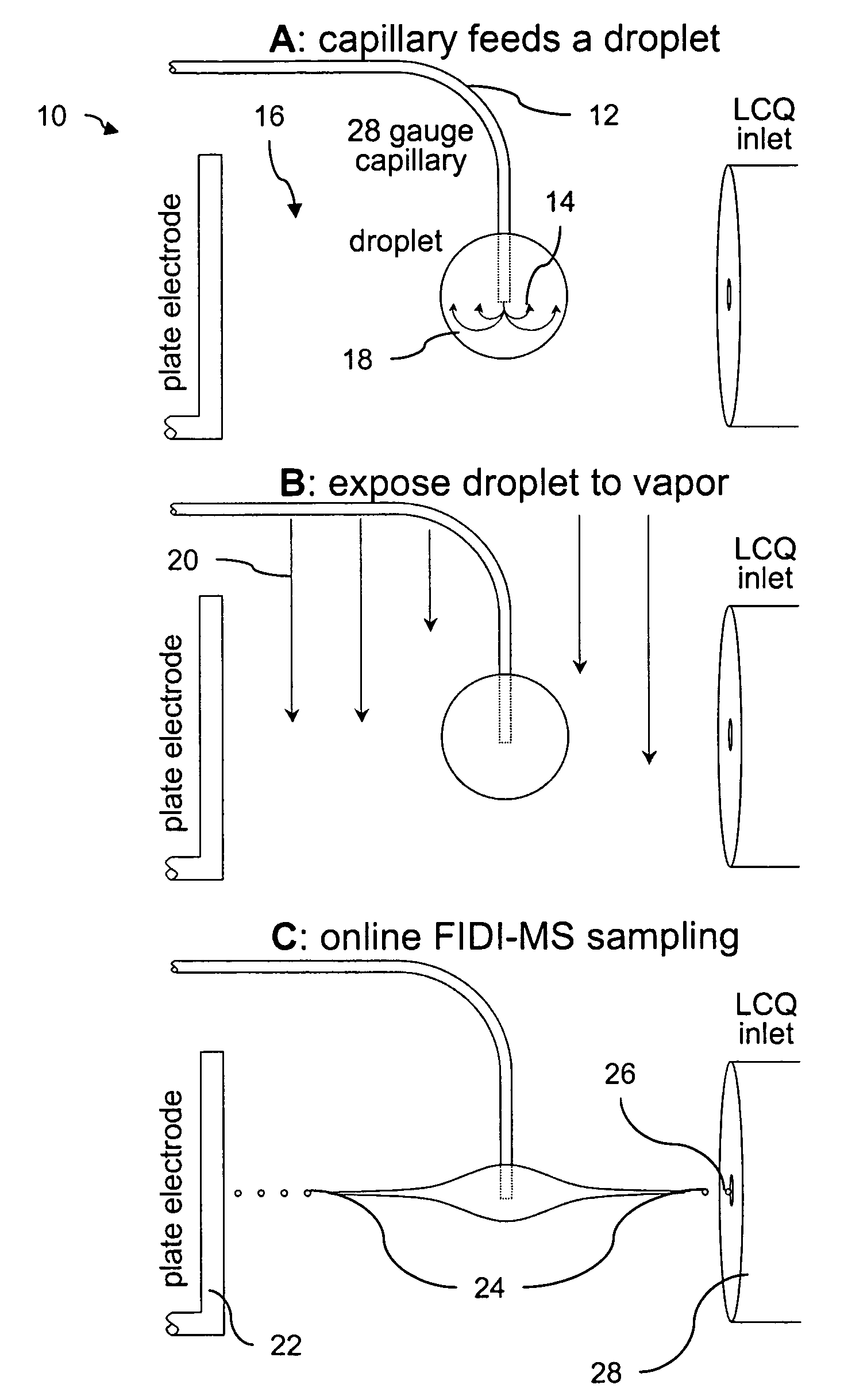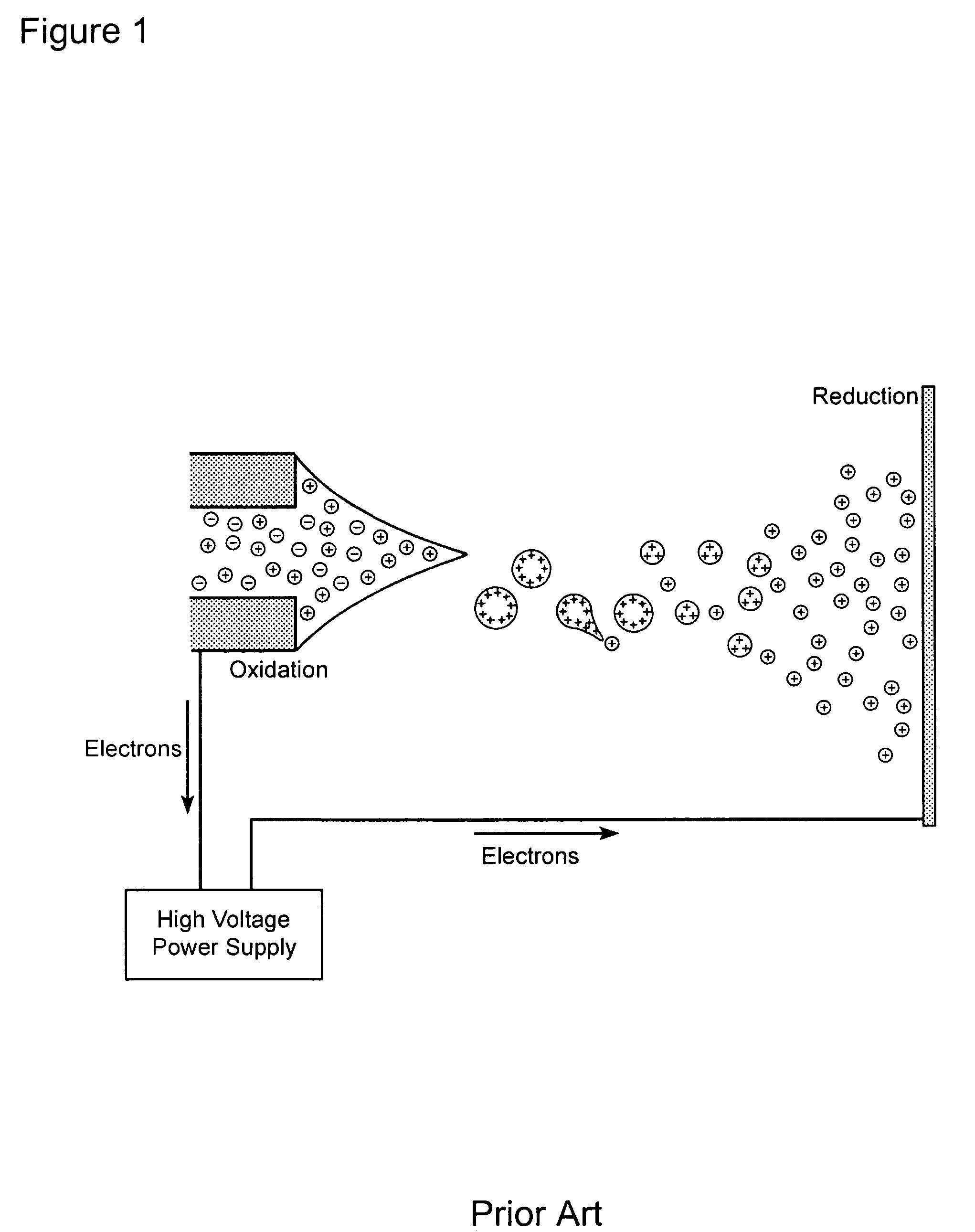Chemical probe using field-induced droplet ionization mass spectrometry
a droplet ionization and chemical probe technology, applied in the field of interfacial chemical probes, can solve the problems of kilovolt differences and electrosprays at the nozzle, low ionization mass spectrometry, and low ionization mass spectrometry, and achieve the effects of reducing the ionization intensity of the sample, and reducing the ionization intensity
- Summary
- Abstract
- Description
- Claims
- Application Information
AI Technical Summary
Benefits of technology
Problems solved by technology
Method used
Image
Examples
example 1
Discussion of Dynamics Example 1
[0094]First an investigation was undertaken to determine the dynamics of droplets in field below Ec0. FIG. 9 highlights a sequence of droplets in a 2.00×106 V m−1 electric field. Initially, γ(0 μs)=1 corresponding to the spherical droplet (a). A damped shape oscillation is marked by increasing aspect ratios in (b)-(e), decreasing aspect ratios in (e)-(i), and increasing again in (j). FIG. 10 highlights this trend in plots of γ versus the time in the electric field for four field strengths below Ec0. Each point represents the average aspect ratio for approximately ten images at each respective time, and is fit to the exponentially damped sine function (6). The fitted equilibrium aspect ratios, γ∞, strictly increase as the electric field increases and are in excellent agreement with Taylor's theoretical model, Equation (3), for each respective electric field.
[0095]FIG. 11 compares the fitted oscillation frequencies from this work (round markers) with th...
example 2
Discussion of Dynamics Example 2
[0096]The second investigation was undertaken to determine the dynamics of neutral droplets in field above Ec0. FIG. 12 shows 225 μm diameter droplets symmetrically elongating and jetting at two field strengths. Droplets oscillate at 2.14×106 V m−1, as shown by FIG. 11 and undergo FIDI in a 2.18×106 V m−1 field, in good agreement with the value of Ec0 predicted by Equation (2). In a 2.18×106 V m−1 field, jetting begins after 650 μs (FIG. 12e), whereas jetting occurs as early as 350 μs in a 2.46×106 V m−1 field (FIG. 12j). Thus, the 13% increase in the electric field above Ec0 accelerates the elongation and reduces the time to form jets by 46%. FIG. 13 graphs γ(t) for fields between 2.18 and 2.42×106 V m−1 as well as the fitted oscillation γ(t) at 2.14×106 V m−1 reproduced from FIG. 11. FIG. 13 illustrates this reduction in time to achieve jetting which results from increasing the applied field. For droplets at Ec0, conical shapes begin to form at aspe...
example 3
Discussion of Dynamics Example 3
[0100]The third investigation was undertaken to determine the dynamics of charged droplets in field above Ec0. FIGS. 14 and 15 show asymmetrical stretching and jetting from charged 225 μm methanol droplets. FIGS. 14a-e shows droplets carrying a charge 0.04 qR in a 2.16×106 V m−1 field and 0.09 qR droplets in a 2.14×106 V m−1 field in frames (f)-(j). In both cases, droplets are exposed to the minimum field required for jetting, Ecq, for each respective q. Similarly, FIG. 15a-h displays a sequence of 0.13 qR droplets at their critical field of 2.09×106 V m−1. The non-linear trend in decreasing critical fields agrees with finite-element calculations. (See, e.g., Basaran, O. A.; Scriven, L. E. Phys. Fluids A 1989, 1, 799, the disclosure of which is incorporated herein by reference.) Similarly, the time to initiate jetting decreases as net charge increases. At 0.04 qR, jet formation occurs at 650 μs as shown in FIG. 14e which is the same timescale observed...
PUM
 Login to View More
Login to View More Abstract
Description
Claims
Application Information
 Login to View More
Login to View More - R&D
- Intellectual Property
- Life Sciences
- Materials
- Tech Scout
- Unparalleled Data Quality
- Higher Quality Content
- 60% Fewer Hallucinations
Browse by: Latest US Patents, China's latest patents, Technical Efficacy Thesaurus, Application Domain, Technology Topic, Popular Technical Reports.
© 2025 PatSnap. All rights reserved.Legal|Privacy policy|Modern Slavery Act Transparency Statement|Sitemap|About US| Contact US: help@patsnap.com



